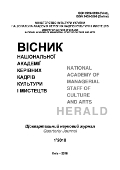EMPOWERING QUALITY QUESTIONS: GENERATING STUDENTS THINKING CAPABILITY
DOI:
https://doi.org/10.32461/2226-3209.1.2018.178804Анотація
Abstract. Addressing the agenda of education in the 21st century requires the commitment of educators to realise the potential of student’s thinking to be synthesised towards mastering their thinking capability at a high level. Therefore, this article is aimed to evaluate the degree of University of Terengganu Malaysia lecturers’ concern among in mastering skills in the formulation of questions, of different types and levels of difficulty, and to apply them in the context of student assessment that affects their thinking capability. Content analysis with a descriptive study together with a checklist instrument to investigate the difficulty level was applied to evaluate a total of 412 questions from 12 courses for the final examination of the program of study. The results showed that the majority of the questions (59%) were constructed using memory questions and only 1% were evaluation questions. Only 12% of the questions were
high-level and the rest (88%) were low-level questions. This result reflected that the question makers had neglected the importance of applying the multiformity of types and difficulty of the questions. Ergo, academic leadership should seriously monitor this matter as it will affect the credibility of the graduates and also education holistically.
Key words: thinking skills, question type, difficulty level of the question, question maker, quality of
questions.
Посилання
Abd., R., & Maria, C. (2001). Hubungan di antara kecerdasan dengan kefahaman membaca di
kalangan pelajar Tingkatan Dua. In Prosiding Konferensi Kebangsaan Kajian Pasca Siswazah.
Barret, T. C. (1972). Taxonomy of reading comprehension. Ginn and Company: Massachusetts.
Bloom, B. S. (1956). Taxonomy of educational objectives: Cognitive domain. Mc Kay: New York.
Brown, G., & Wragg, E. C. (1993). Questioning. Routledge: London.
Clasen, D. R., & Bonk, C. (1990). Teachers tackle thinking. Madison Education Extension Program:
Wisconsin.
Cole, R. A., & Williams, D. M. (1973). Pupil responses to teacher’s question: Cognitive level, length
and syntax. Educational Leardership, 31, 142-145.
De La Cruz, L. D. (1971). An analysis of Philippe social studies textbooks. Dissertation Abstracts
International, 32(1), 665-A.
Dillon, J. T. (1981). Duration of response to teacher’s questions and statements. Contemporary
Educational Psychology, 6, 1-11.
Duster, S. (1998). Classroom questioning: How teachers use it to promote creativity and higher level
thinking. Dissertation Abstract International, 36(1), 19.
Elder, L., & Paul, R. W. (1998). The role of socratic questioning in thinking, teaching and learning.
The Clearing House, 71(5), 297-301.
Gall, M. (1984). Synthesis of research on teachers’ questioning. Educational Leadreship, 42, 40-47.
Guszak, F. J. (1967). Teacher questioning and reading. The Reading Teacher, 21, 227-234.
Kementerian Pendidikan Malaysia (KPM). (2014). Kemahiran berfikir aras tinggi aplikasi di sekolah.
Cepat Cetak Sdn. Bhd: Selangor.
Lewis, A., & Smith, D. (1993). Defining Higher Order Thinking. Theory into Practice, 32, 131-137.
Mahyuddin, A. (2001). Strategi pendekatan penyayang dalam pendidikan. Jurnal Pendidikan Islam,
(3), 1-7.
Marohaini, Y. (1989). Strategi pengajaran bacaan dan kefahaman. Karya Bistari Sdn. Bhd: Kuala
Lmpur.
McKenzie, J. (1997). A questioning toolkit. Educational Technology Journal, 7(3), 1-6.
Newmann, F. (1990). Higher order thinking in teaching social studies: A rationale for the assessment of
classroom thoughtfulness. Journal of Curriculum Studies, 22(1), 41-56.
Noor, R. M. (2005). Kompleksiti soalan dalam bahan implimentasi kurikulum pengajaran dan
pembelajaran bahasa: Meninjau kemantapan kualiti soalan dalam proses pengajaran-pembelajaran bahasa ke
arah peningkatan profesionalisme guru. In Seminar Penyelidikan Pendidikan MPBL, pp. 1-18.
Noor, R. M. (1996). Analisis soalan kefahaman dalam buku kerja Bahasa Melayu peringkat menengah
atas. Master thesis, Universiti Malaya.
Noor, R. M. (2004). Kompleksiti soalan dalam bahan implimentasi kurikulum pengajaran dan
pembelajaran bahasa: meninjau kemantapan kualiti soalan dalam proses pengajaran-pembelajaran bahasa ke
arah peningkatan profesionalisme guru.
http://www.ipbl.edu.my/portal/penyelidikan/seminarpapers/2005/noorKUSTEM.pdf.
Noor, R. M. (2013). Tahap berfikir dalam bahan kurikulum bahasa. UMT Press: Terengganu.
Onosko, J. J., & Newmann, F. M. (1994). Creating more thoughtful learning environment. In J.
Mangieri, & C. C. Blocks (Eds.), Creating Powerful Thinking in Teachers and Students: Diverse Perspectives.
Harcourt Brace College Publishers: Texas, pp. 27-49.
Rafiei, M. (1998). Kajian tentang kemahiran berfikir secara kristis dan kreatif (KBKK) dalam
pengajaran dan pembelajaran Bahasa Melayu sekolah menengah.
http://members.tripod.com/~Devadason/seminar/Rafiei.html.
Rawadieh, S. M. (1998). An analysis of the cognitive levels of questions in Jordanian secondary Social
Studies textbooks according to Bloom’s taxonomy. Dissertations Abstracts International, 59 (4), 1060-A.
Ruddell, R. B. (1974). Reading-language instruction: Innovative practices. Prentice-Hall: California.
Sanders, N. M. (1966). Classroom question: What kinds? Harper and Row: New York.
Forgan, H. W., & Mangrum, C. T. (1981). Teaching content area reading skills: A modular preservice
and inservice program. Merrill Publishing Company: Ohio.
Schiever, S. W. (1991). A comprehension approach to teaching thinking. Allyn and Bacon:
Massachusetts
Smith, C. T. (1978). Evaluating answers to comprehension questions. The Reading Teacher, 31, 896-
Swarts, R. J., & Perkins, D. N. (1990). Teaching thinking issues and approaches. Midwest Publications:
California.
U.S. Department of Education (USDOE). (1980). What works: Research about teaching and learning.
USDOE: Washington.
Wilson, I. A. (1973). Changes in mean levels of thinking in grades 1-8 through use of an interaction
system based on Bloom’s taxonomy. Journal of Educational Research, 66, 13-50.
##submission.downloads##
Номер
Розділ
Ліцензія
Автори, які публікуються у цьому журналі, погоджуються з наступними умовами:
1. Автори залишають за собою право на авторство своєї роботи та передають журналу право першої публікації цієї роботи на умовах ліцензії Creative Commons Attribution License International CC-BY, котра дозволяє іншим особам вільно розповсюджувати опубліковану роботу з обов'язковим посиланням на авторів оригінальної роботи та першу публікацію роботи у цьому журналі.
2. Автори мають право укладати самостійні додаткові угоди щодо неексклюзивного розповсюдження роботи у тому вигляді, в якому вона була опублікована цим журналом (наприклад, розміщувати роботу в електронному сховищі установи або публікувати у складі монографії), за умови збереження посилання на першу публікацію роботи у цьому журналі.
3.Політика журналу дозволяє і заохочує розміщення авторами в мережі Інтернет (наприклад, у сховищах установ або на особистих веб-сайтах) рукопису роботи, як до подання цього рукопису до редакції, так і під час його редакційного опрацювання, оскільки це сприяє виникненню продуктивної наукової дискусії та позитивно позначається на оперативності та динаміці цитування опублікованої роботи.

